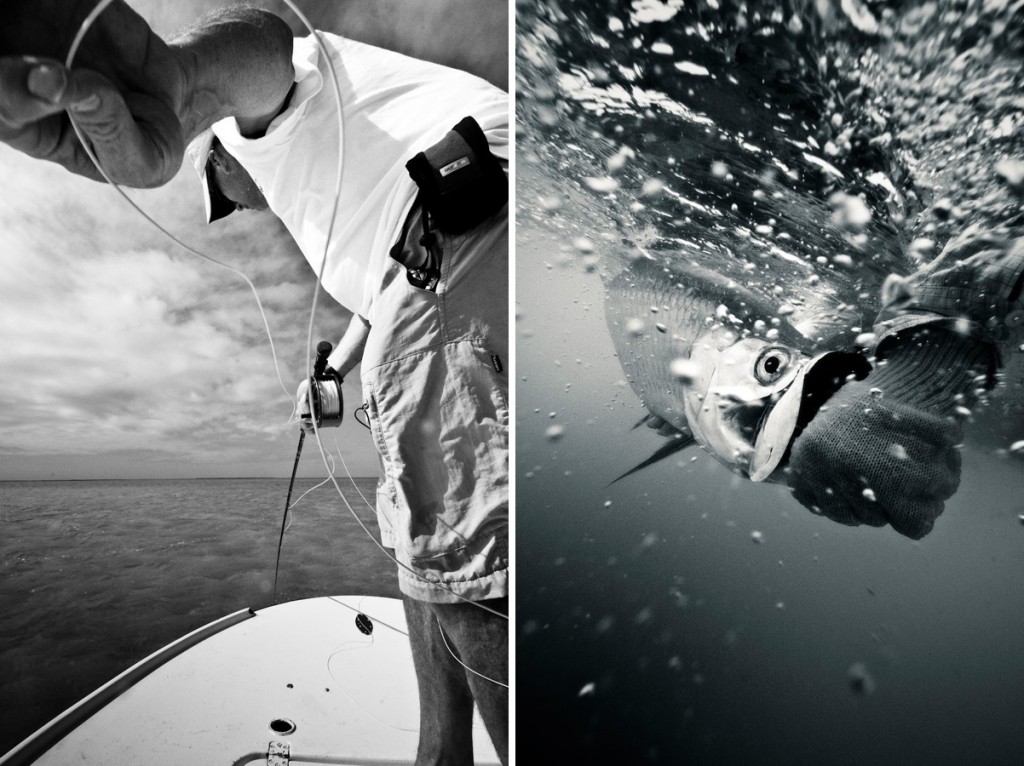I can remember like it was yesterday jumping my first big tarpon in the Florida Keys.
One hundred plus pounds of fish completely leaping out of the water and crashing down like a free falling Volkswagen Bug. That image will forever be burned into my memory. The only problem is I didn’t end up landing that tarpon. To be brutally honest, my hook set totally sucked donkey balls. I know what your thinking. I’m a trout guide, and I probably set the hook like I was trying to hook a trout, right? Yes, I’ve done that before, but my mistake this time was only setting the hook once. Below are five tips for getting better hookups with tarpon, provided by Capt. Joel Dickey.
4 Tips for Getting Better Hookups With Tarpon
1. Keep your rod tip on the water and always point it in the direction of your fly line and fly during your retrieve.
Not pointing your rod tip at your fly line and fly often results in adding unwanted slack between you and the fish. This small amount of slack will increase your chances of not getting a solid hook set. You also will find it hard to feel the bite.
2. Use a 100% strip set when setting the hook.
You can apply far more pressure and power in a hook set with a firm strip set than you can with the fly rod. Many novice saltwater anglers make the mistake of thinking the power comes from the fly rod.
3. Set the hook multiple times for better hook penetration.
When a tarpon eats from left or right often a single hook set will be adequate because a lot of the time the weight of the fish moving aids in setting the hook. However, when you have a tarpon eating and moving at you it’s important to hit the fish multiple times while taking up slack between hook sets. This will help maintain constant tension with the fish.
4. Make sure you set the hook hard enough.
Don’t be afraid to hit the tarpon extra hard. With their hard boney mouths it’s crucial to get adequate power in your hook set to ensure you get full penetration to the barb. Saltwater guides are always telling me their clients often set the hook far to light.
Keep it Reel,
Kent Klewein Gink & Gasoline www.ginkandgasoline.com hookups@ginkandgasoline.com

Pingback: Fly Fishing Articles | Good posts we think you’ll like
Pingback: 11 Tips for Correctly Presenting Your Fly To Tarpon | Gink and Gasoline, The Blog home of Kent Klewein and Louis Cahill-Fly Fishing photography, video, tips and news.
A smooth steady pull sets the hook better than multiple fast jabs. Proven. In fact anyone can experiment with this. Simply take a tarpon fly, attach it to a leader, and toss it into a cardboard box (with some weight in it to keep it still). Now, jerk the fly fast. See? Toss it back in and make a steady pull. See the difference? This is one of the reasons trout-sets don’t work on tarpon (or bonefish or permit) — the flyrod tip has lots of speed, but no power.
Pingback: My Mistakes. Tarpon Hook Setting | Bonefish on the Brain
Pingback: Saltwater Fly Fishing: 11 Tips for Presenting Your Fly To Tarpon | Fly Fishing | Gink and Gasoline | How to Fly Fish | Trout Fishing | Fly Tying | Fly Fishing Blog
Pingback: ANYONE THAT'S FLY FISHED FOR TARPON HAS PROBABLY EXPERIENCED HOW EASY IT IS TO PRESENT THE FLY INCORRECTLY. If you miss your target, even by just a little bit, it can drastically lower your chances for getting a tarpon to eat. Cast the fly too close, and
Pingback: 11 Tips for Correctly Presenting Your Fly To Tarpon | Fly Fishing | Gink and Gasoline | How to Fly Fish | Trout Fishing | Fly Tying | Fly Fishing Blog